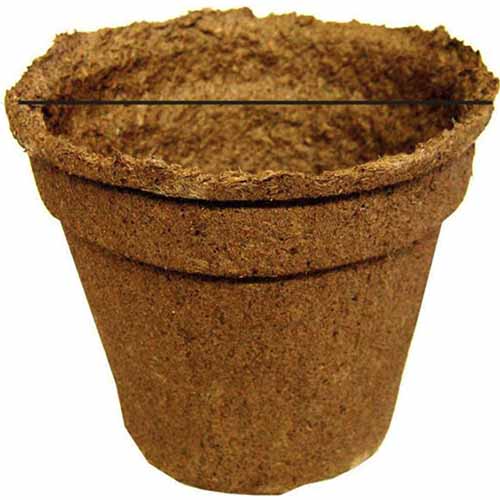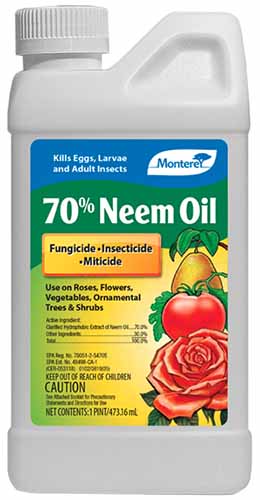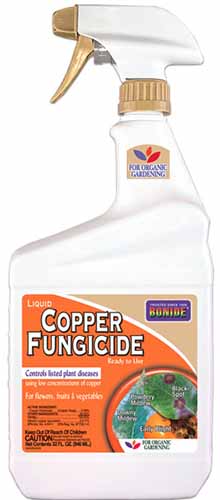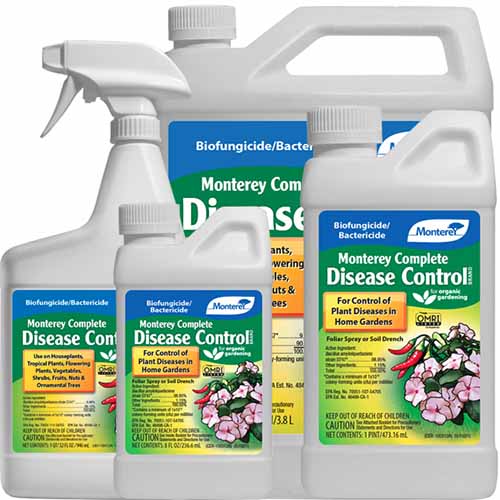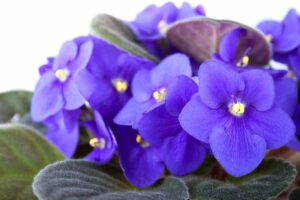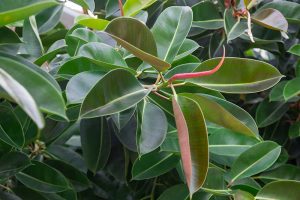Peperomia spp.
Peperomias are marvelously diverse, ranging from petite bright green plants that trail out of hanging baskets to two-foot-tall upright specimens with striking wrinkled foliage and purple stems.
Some look like succulents, while others are bushy and lush.
What they have in common is that they’re all tolerant of drought, don’t demand much light, and they add gorgeous greenery to your home without much maintenance at all.
Propagating them is easy, and they won’t be upset if you take a vacation and leave them to their own devices.
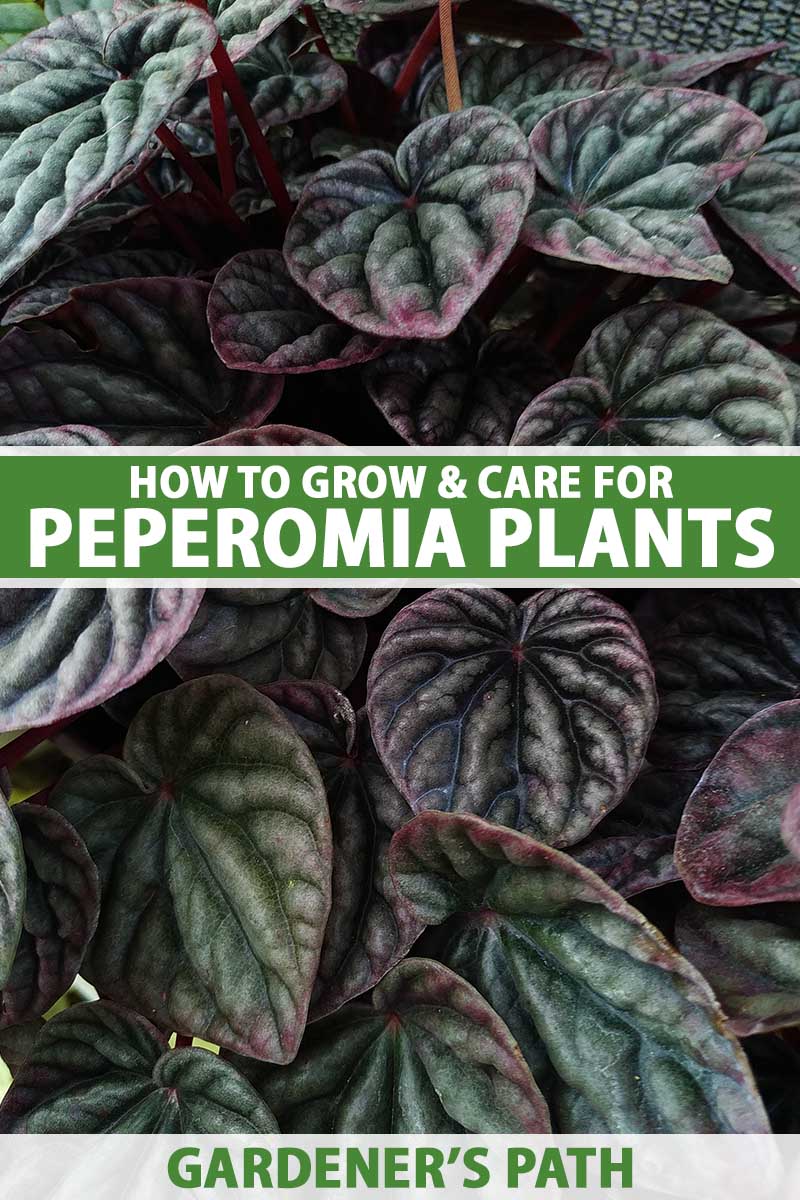
We link to vendors to help you find relevant products. If you buy from one of our links, we may earn a commission.
They’re truly ideal houseplants for beginners and experienced growers alike.
This guide will teach you how to propagate, plant, and help your peperomias to thrive.
Here’s what we’ll explore:
What You’ll Learn
Whether this is your first peperomia or you just want to make the ones you already have a little happier, I’m sure you can’t wait to dive in, so let’s go!
Cultivation and History
Peperomia refers to a genus of plants that includes over 1,000 species, though only a fraction of these are commonly grown as houseplants.
They’re part of the pepper family (Piperaceae), and the houseplants in this genus are sometimes referred to as radiator plants.
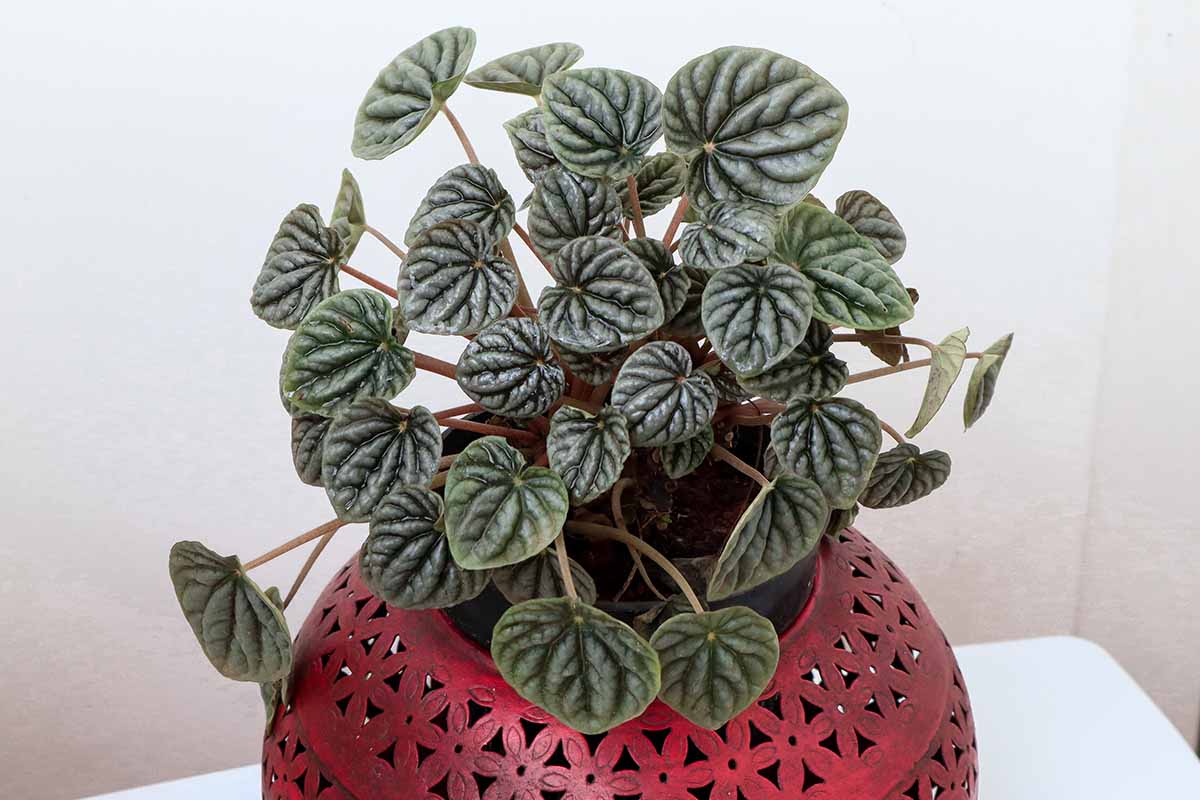
Peperomias are native to tropical areas in South America, southern parts of North America, and parts of Asia and Africa. Most, however, come from the Americas.
They are semi-succulent, with thick leaves or stems that can store water – even if you forget to come around with the watering can for a bit too long. They tend to absorb more moisture from the air than the soil.
As such, many are epiphytic, which means they grow on the surface of other plants. The epiphytic types typically come from rainforests, where they thrive in the dappled sunlight of the understory.
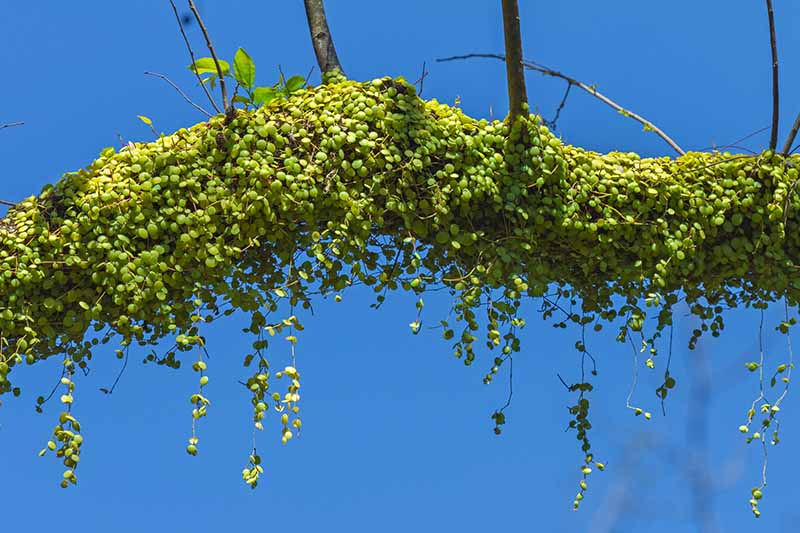
Others grow in the soil (terrestrial types) or on rocks (lithophytic varieties). Some terrestrial types are geophytic, which means they have large underground tuberous roots that can store lots of water and nutrients.
You’ll usually find geophytic types in drier regions such as parts of Mexico. These are less common to see growing as houseplants.
In general, peperomias aren’t terribly picky about water, sunlight, or food, which makes them suitable low-maintenance options in the home.
In their native habitat, peperomias usually live in partially shaded areas that are damp and moist. You can even plant them outdoors in USDA Hardiness Zones 10 and 11.
Most stay pretty small, and you can find species that never grow more than a few inches tall, while others climb closer to two feet tall at maturity.
Plants in this genus might flower when they’re happy with the conditions that they’re planted in, even when they are growing indoors. That sets them apart from many other varieties of houseplants, which don’t bloom often inside the home.
The bad news is that the flowers aren’t showy or heavily scented. They look like little spikes, and lack any petals or sepals.

Many species are edible, though you should check on your specific species to be sure. They aren’t toxic to pets such as dogs or cats.
The pepper elder, P. pellucida – also known as shining bush and called coraçãozinho in Portuguese – has historically been used in South America as a source of food and medicine. Today, it has spread globally as both a treatment for certain diseases and a houseplant.
P. pellucida has been found to show promise as a treatment for certain types of cancer, as a supplement to improve fracture healing, and as an antioxidant and antimicrobial.
Peperomia Plant Propagation
There are several ways you can go about propagating peperomia, but rooting stem cuttings is the easiest.
From Seed
It’s best to purchase seeds rather than trying to extract them from a mature plant yourself. It’s difficult to extract the tiny seeds, knowing when the seeds are mature is a challenge, and the germination rate is low.
Also, be aware that there are a few radiator plant hybrids out there, such as ‘Hope,’ which is a cross between P. deppeana and P. quadrifolia. Seeds saved from hybrid peperomias won’t grow true to type.
To plant your seeds, fill a container with a soilless seed-starting mixture. You can either use seed starting pots or start your plant right in its new home.
I like to reuse old containers that my plants came in from the nursery, just be sure to clean them in a 10 percent bleach solution (one part bleach to nine parts water) first. Or, try a biodegradable option such as CowPots. Both of these are much better for the environment than buying new plastic pots.
I always keep a bunch of CowPots around to meet my seed planting needs, as they’re a completely renewable resource.
They’re made out of cow manure, and they biodegrade right into the soil so you can toss them in the compost or garden when your new plant is ready to transplant.
If you’d like to pick some up for your gardening supply kit, Arbico Organics carries the five-inch round size – which is a handy all-around size to have on hand – in packs of 66 or 160.
Plant your peperomia seed as deep as the packet suggests, which is generally about 1/4 inch deep, and water well so the medium is moist but not saturated.
Place the pot in a spot where it will receive bright, indirect light for several hours a day. A south-facing window with a sheer curtain over it is ideal.
Then, tent a plastic bag over the container to help retain moisture. Essentially, you’re creating a tiny greenhouse.
Open the plastic once every day, and touch the soil. Does it feel like a well-wrung-out sponge? No need to do anything, in that case. If it feels dry, add some water.
Within a few weeks, you should see some green sprouting out of the soil.
Once the seedling is a few inches tall and has several leaves – which can take a few weeks or more, depending on the species – you can transplant it into its permanent home, if necessary. That process is described below.
From Cuttings
Start by prepping a small container and filling it with a soilless seed-starting mixture, as described above for starting seeds.
Next, take a cutting from the mother plant. How much and where to clip depends on the species.
Some radiator plants grow out of a cluster of central stems. If yours is like this, snip a cutting that includes a node and is several inches long. Aim for a stem with two to three leaves.
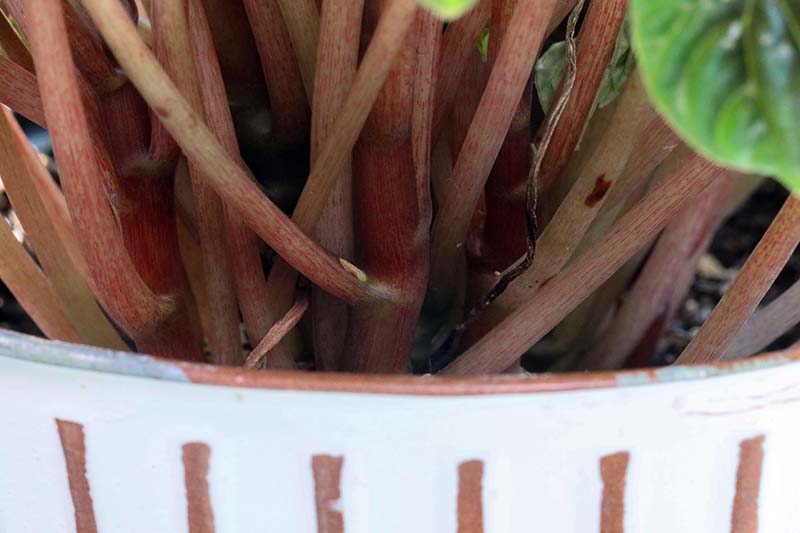
If your species has single stems growing out of the soil, snip one of the stems as close to the soil surface as possible.
If you want to reproduce a variegated cultivar, you must take a cutting that includes at least one or more terminal buds. A terminal bud is the end of a shoot where new growth will emerge.
Now, gently press the cutting into the medium so the stem is about an inch deep, and water well.
If you live in a very dry region, or it is the middle of winter and you have your forced air furnace running all the time, you might want to tent plastic over the cutting to increase the moisture around it.
Use a chopstick or a stick, and stick it into the medium about an inch away from the cutting. Then, gently place a clear plastic bag over the container.
You can also put your cutting in a cup of water instead of soil. Replace the water once a week if you go this route.
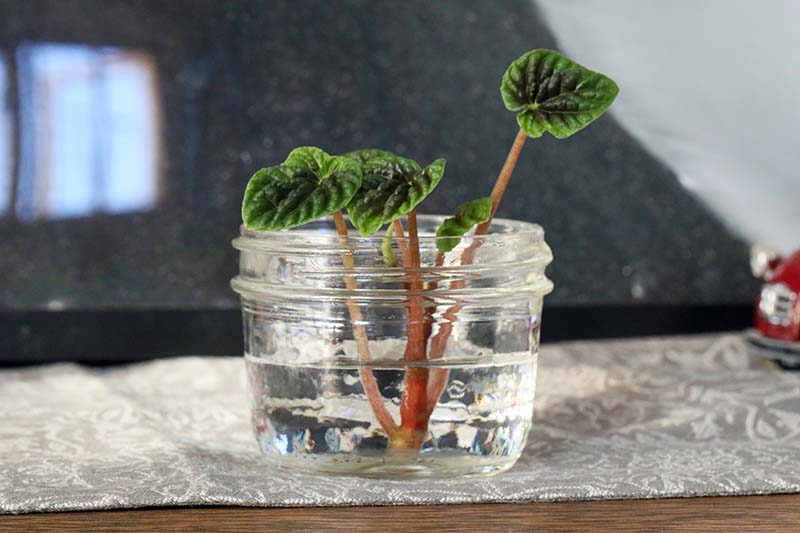
Place the pot next to a window where it will receive several hours of bright, indirect light each day, and keep the soil moist but not wet.
Within a few weeks, new leaves or stems should start forming. If your cutting is in water, you should be able to see the new roots.
At this point, transplant the rooted cutting into a permanent container as described below.
From Divisions
Most, though not all, species of peperomia grow in clusters with multiple stems extending out of a single root ball. You can cut away one or more of these stems to divide your peperomia into multiple plants. The process is fairly straightforward.
Remove your peperomia from the container it is growing in, and knock or rinse away as much of the soil as you can. Take a clean, sharp pair of scissors and cut through a section of roots that includes the stem you want to separate from the rest of the plant.
Plant the part that you cut away as you would a transplant. Repot the remaining portion of your plant in its previous container with some fresh soil.
From Transplants
If you’ve purchased a new beauty or you’ve been growing one of your own from a cutting, division, or seed, at some point you’ll need to transplant it into a new container. Transplanting the right way helps to minimize stress.
To transplant, gently remove the peperomia, soil and all, from its existing container. Knock away as much of the loose soil as you can from the roots. You want to replace some of this existing soil when you put your peperomia in its new home.
Make sure to select a pot that has at least one drainage hole and that is a few inches larger in diameter than the base of the stems.
Prep a container by filling the base with enough potting soil so the plant will be sitting at the level you prefer.
The stems should be placed at the same height they were in their previous container – don’t heap more soil around them as you plant – and about an inch below the lip of the pot.
Fill in around the roots with more potting soil. Peperomias do best in water-retentive soil, which is a medium that contains some coconut coir, peat moss, vermiculite, rice husks, or some combination of these.
Tank’s-Pro Potting Mix is a good option with a mix of coco coir and compost. Our pals at Arbico Organics carry bags containing one and a half cubic feet of soil.
Give the peperomia some water to help settle the soil, and then add a bit more soil if it has settled further than you’d like below the lip.
How to Grow Radiator Plants
Peperomias are incredibly easy to grow, but there are a few things to do to keep them looking and growing their best.
Direct light is no good. Peperomias need indirect light, though plenty of it won’t hurt them, so long as direct sunlight isn’t hitting them.
Full shade isn’t ideal either. Though plants will survive in full shade, they will likely be spindly and less attractive than they could be.
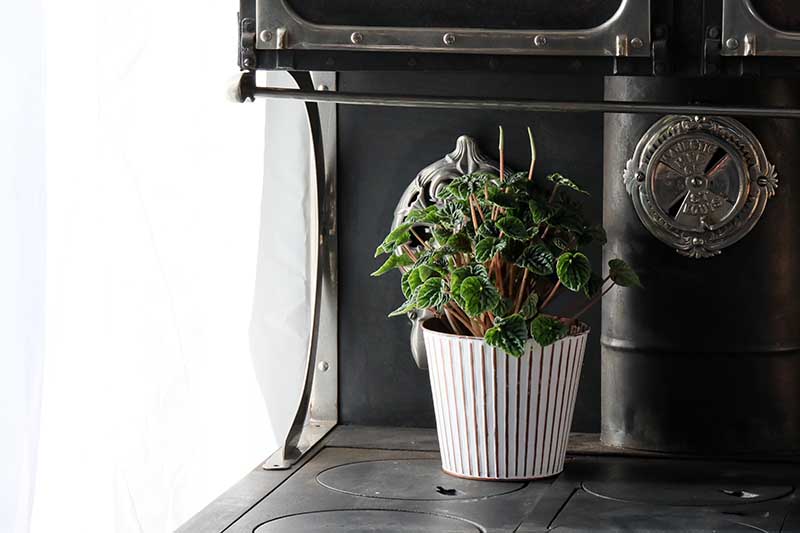
When it comes to water, keep in mind that while peperomias sometimes grow in wet, tropical areas, these semi-succulents can retain water for up to several weeks.
That means you should aim for underwatering rather than overwatering.
These beauties are particularly sensitive to water-logged soil and will suffocate if you give them too much moisture. This also increases the risk that they will contract a fungal disease.
Let the top inch of soil dry out between watering. Just stick your finger into the soil and see if it feels moist. Once the top inch dries out, add more water.
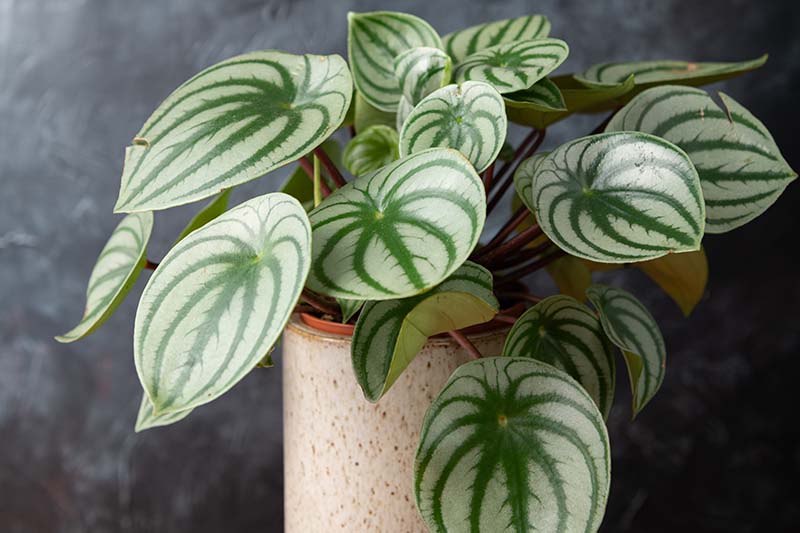
When a radiator plant is stressed, it may drop its leaves. This likely means it’s receiving too little or too much sunlight, or too little or too much water.
If you repot your peperomia once a year, you won’t need to add fertilizer, since potting mixes contain enough food to keep these plants happy.
If you only repot every few years, then you’ll want to add some fertilizer in the second year after repotting.
An all-purpose houseplant fertilizer will do the job nicely. You can purchase slow-release pellets, spikes, or liquid fertilizer.
I like to set it and forget it, so I prefer something like Osmocote’s PotShots, which slowly release food for six months.
Amazon carries this handy product in 25-count packages of nuggets, or try Osmocote Plus in one-pound, two-pound, and eight-pound containers and bags of granules.

Speaking of repotting, it’s a good idea to size up your container once every year or two, depending on how quickly it is growing. Peperomias located in heavier shade tend to grow much slower than those in bright light.
The pot should extend a few inches wider around the perimeter than the diameter of the base of the stem. In other words, once the peperomia stems start to reach the edges of the pot, it’s time to go up a size.
The exception to this is those species that have a trailing growth habit. Let these reach the edge of the pot to contain their spread. You can repot every few years if you desire, or just change out some of the soil to help refresh it.
After a few years, the plant will reach its mature size and will stop expanding. At this point, divide it and it will fill up the container once again. Be sure to use fresh potting soil when repotting the divisions.
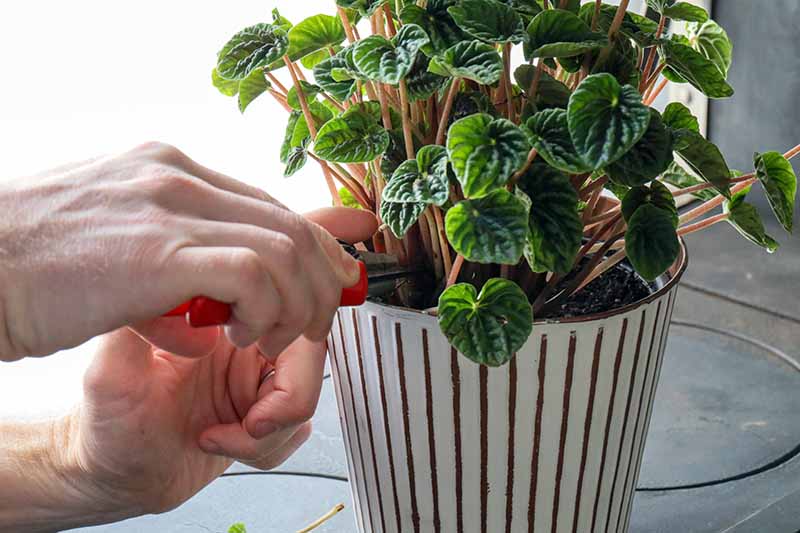
There is no need to prune peperomias, but you can trim them down to size or remove sad-looking, dead, or diseased stems at any time.
Growing Tips
- Allow the top inch of soil to dry out between watering.
- Repot every year or two.
- Place in indirect, bright light.
Species and Cultivars to Select
The most common species are beetle (P. angulata), watermelon (P. argyreia), and emerald ripple peperomia (P. caperata).

These have proven over the years to be healthy, reliable growers in the average home. The baby rubber plant (P. obtusifolia) is also quite popular.
P. maculosa looks like the pepper-family plant it is, with glossy, oval-shaped leaves that end in a sharp point, and pronounced veins. They’re less common than other species, but just as lovely.
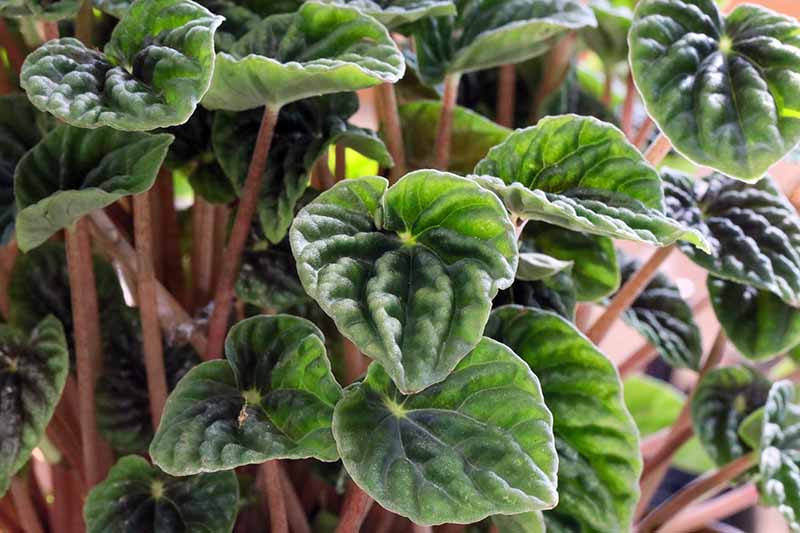
If you want to learn more about these and other species for the home, we have an entire guide dedicated to the many varieties of this hardy and diverse plant.
Managing Pests and Disease
Peperomias are generally very hardy against pests and diseases. That’s one of the things that makes them so lovely as houseplants. They are not immune, however. Here’s what to watch for:
Insects
The usual pest suspects that impact most houseplants will also take a nibble out of peperomias.
Beyond harming plants, they can also increase the chances of disease, so don’t let an infestation become a bigger problem.
Aphids
Aphids are incredibly prolific. There is hardly anything growing in your home or garden that they won’t feed on.
When it comes to houseplants, the green peach aphid (Myzus persicae) is the one to watch for, though you might occasionally see a different species. No matter, they’re all handled the same way.

An aphid infestation can cause yellowing leaves, or even stunted growth.
You need to look closely at your plant to see aphids. They’re small – we’re talking three millimeters in length. They can be green, yellow, peach, orange, or pink, and may or may not have wings.
The simplest way to deal with an aphid infestation is to put your plant in the shower or tub, and spray it to knock the pests loose.
Do this repeatedly for several weeks. If that doesn’t work, neem oil or insecticidal soap are effective treatment options.
If you’re serious about keeping your houseplants healthy, you should keep a bottle of one (or both) of these around.
They’re pretty indispensable. Arbico Organics carries Monterey brand neem oil in 32-ounce ready-to-use or 16-ounce ready-to-spray bottles, as well as eight-ounce, pint, and gallon concentrates.
Spray your plants once a week or so until the aphids are gone, taking care to cover the stems as well as the leaves.
Fungus Gnats
Have you noticed tiny black flies scurrying across the soil of your houseplants? Maybe you see little clouds of bugs fly up when you disturb the foliage or the container?
You likely have fungus gnats, which are tiny gnats from the order Diptera.
The gnats themselves aren’t a big deal, they’re mostly just annoying when they flit around near you, but the larvae feed on the roots and lower stems of plants.
Not only can this weaken the plant if they’re around in great enough numbers, but it leaves an opening for disease pathogens to come hang out.
Fungus gnats thrive in wet soil and feed on decaying plant matter, so take care not to overwater and you will greatly reduce the chances that this will become a problem in your indoor garden.
You should also remove any fallen leaves from the soil whenever you see them.
If you’re careful not to overwater and these little pests are still a problem, buy yourself some yellow sticky traps. I like these by Dwcom because they come in fun shapes.

Grab some for yourself at Amazon in packs of 24.
During the summer, I have seen these yellow cards fill up with the carcasses of fungus gnats to the point where the entire thing turns black. Combined with reducing watering, this is enough to eliminate an infestation.
Spider Mites
Spider mites are arachnids in the family Tetranychidae. The most common to infest indoor plants is the red spider mite, Tetranychus urticae.
It’s likely that you won’t see the mites themselves unless you look reeeaallyy close, but you probably will see fine webbing on your plant. They can cause yellow stippling and a general lack of vigor as well.
Spider mites don’t love peperomias if they’re kept fairly moist, but if you let your plant dry out, mites may come to visit. One of the easiest ways to keep spider mites away – or even get rid of them – is to up the humidity.
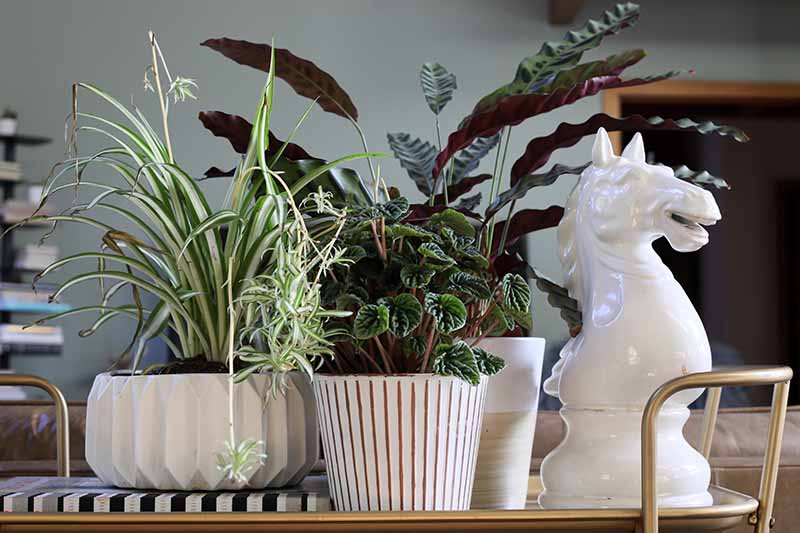
Now, remember that these semi-succulent beauties don’t need a ton of moisture in the soil, and excessive soil moisture can bring about a whole slew of other problems.
Instead, raise the air humidity by spraying the foliage once a day, or placing the container near a humidifier. You can even group them with other houseplants to raise the collective humidity surrounding them.
If you don’t want to go this route, no worries. Just treat your plant as described above under the section on aphids.
Disease
On the whole, peperomias are pretty darn tough.
They aren’t one of those plants that is constantly battling one disease or another. But nothing alive is immune to problems, so here are the ailments you might need to watch out for.
Cercospora Leaf Spot
Caused by fungi in the Cercospora genus, this disease causes black or tan raised spots on the underside of the foliage. P. obtusifolia cultivars are particularly at risk.
If these spots show up, your best method of control is to use a copper fungicide. Spray the undersides of the leaves to ensure that you are coating the fungal spores.
Bonide Liquid Copper Fungicide
Bonide Liquid Fungicide – which Arbico Organics carries in a variety of ready to use and concentrated versions – is a reliable option.
Phyllosticta Leaf Spot
This is a disease that you only need to watch for if you are growing P. argyreia. It’s caused by fungi in the Phyllosticta genus.
When this disease is present, you’ll often see dark brown or black spots surrounded by a ring of light brown. You may also see dark areas on the margins of the leaves. These will eventually expand and cover the entire leaf.
Prune away infected leaves, and spray your peperomia once a week with a copper fungicide.
Ring Spot
Caused by the peperomia ring spot virus, this disease causes spots and leaf distortion. P. otusifolia may also be stunted.
Because this is a viral disease, there isn’t much you can do to cure the problem. If you don’t have any other plants in the same genus in your home, you can just cut off any symptomatic leaves and hope for the best.
Otherwise, toss the whole thing out to prevent further spread.
Be sure to clean the pot the poor thing was growing in with a solution of bleach and water before planting anything else in there. Or better yet, don’t put anything in the same genus in that container again – ever.
To avoid spreading the virus in the future, always clean your tools and hands between handling peperomias.
Root and Stem Rot
One of the most common diseases of peperomias is root and stem rot, which is caused by fungi and oomycetes in the Pythium and Phytophthora genera.
P. obtusifolia and its cultivars are more susceptible than other species.
These pathogens need moisture to thrive, so the first thing to do is reduce watering. Then, nab yourself a fungicide that contains the beneficial bacteria Bacillus amyloliquefaciens strain d747.
This bacteria works its way into the soil and prevents these pathogens from becoming established. It also kills them when they are present on the stems and leaves.
Monterey Complete Disease Control
Monterey Complete Disease Control is a good option if you don’t have a product like this in your arsenal already. Arbico Organics has it in 32-ounce ready-to-use sprays, and eight-ounce, pint, or gallon concentrates.
Quick Reference Growing Guide
| Plant Type: | Herbaceous perennial | Maintenance: | Low |
| Native to: | South America, southern North America, Africa, Asia | Tolerance: | Some drought, full shade |
| Hardiness (USDA Zone): | 10-11 | Soil Type: | Loamy |
| Exposure: | Bright, indirect light | Soil pH: | 6.0-7.0 |
| Time to Maturity: | Up to 5 years indoors | Soil Drainage: | Well-draining |
| Planting Depth: | 1/4 inch (seeds), depth of roots (transplants) | Uses: | Houseplant |
| Height: | Up to 3 feet, depending on species | Order: | Piperales |
| Spread: | Up to 4 feet, depending on species | Family: | Piperaceae |
| Water Needs: | Moderate | Genus: | Peperomia |
| Common Pests and Diseases: | Aphids, fungus gnats, spider mites; Cercospora leaf spot, Phyllosticta leaf spot, ring spot, root and stem rot | Species: | Alata, angulata, argyreia, blanda, caperata, clusiifolia, graveolens, griseoargentea, nivalis, obtusifolia, orba, pellucida, polybotrya, prostrata, puteolata, rotundifolia, scandens, tetraphylla, wheeleri |
Pamper Those Pretty Peperomias
This is a houseplant that has a lot to offer without asking for much in return. It’s hardy, unfussy about water and light (so long as it isn’t too bright), and the foliage is pretty darn showy.
It’s hard not to notice the heavily wrinkled or remarkably colored leaves when they’re on display in your kitchen or living room.
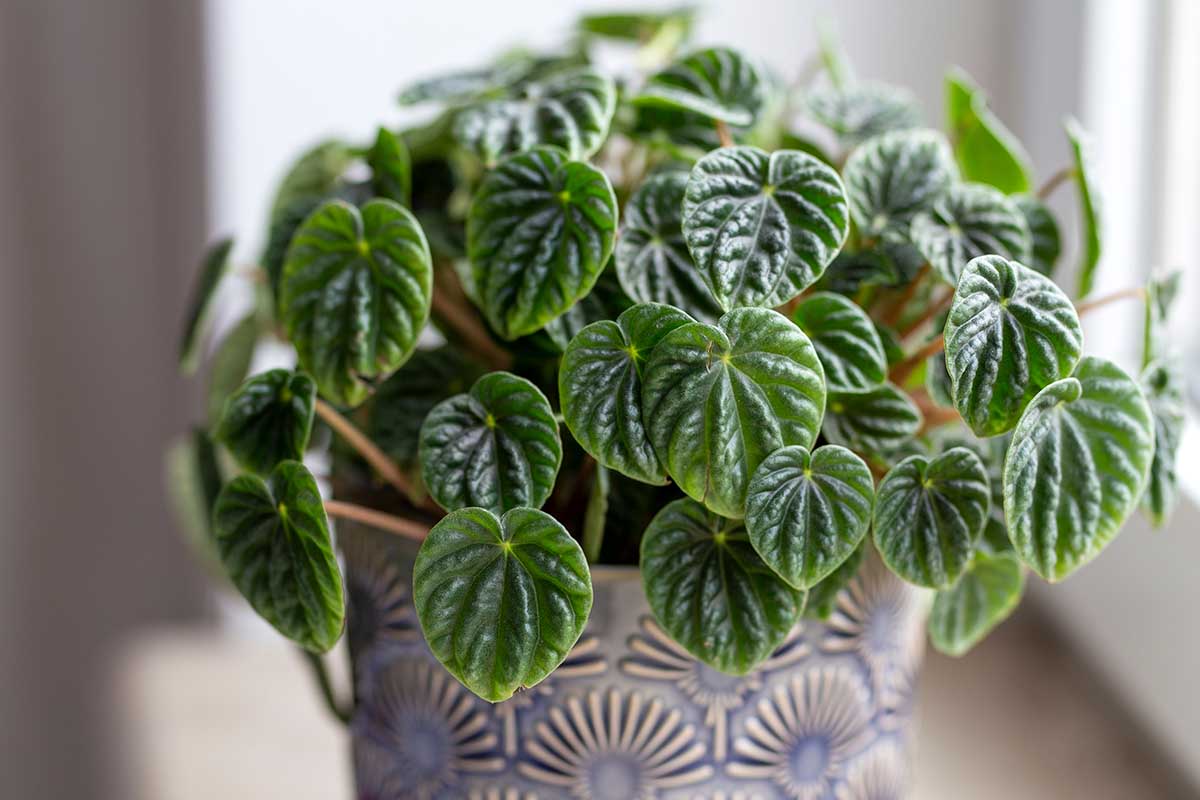
It’s also nice to find a plant that isn’t a risk to curious pets, right? Which species have you fallen in love with? Let us know in the comments section below!
Looking for a bit more houseplant fun? Several other guides might interest you, starting with these:
